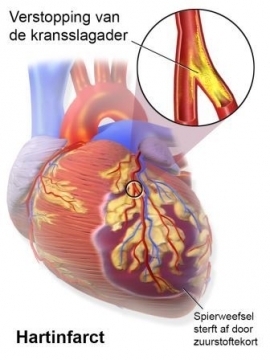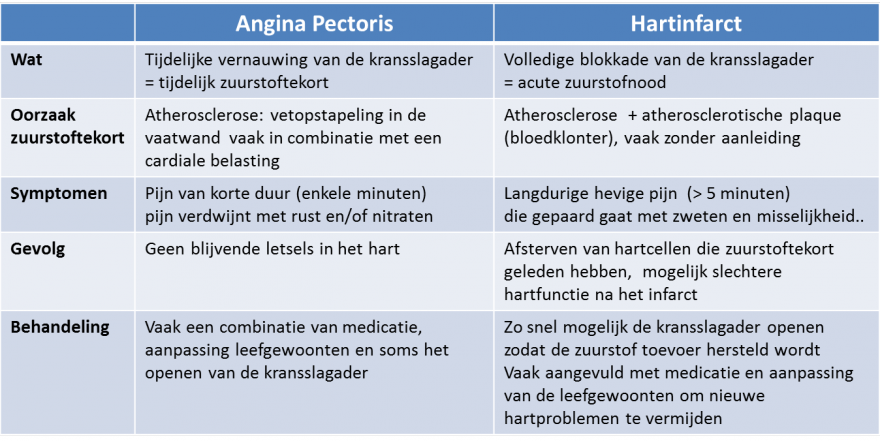Coronary artery disease
Symptoms and causes
Symptoms and causesWhat is it?
Coronary artery disease is a narrowing or blockage of the coronary arteries caused by a fat deposit in the vascular wall. The coronary arteries are responsible for the supply of oxygen to the heart. Coronary artery disease leads to a lack of oxygen in the heart.
Depending on the symptoms and the oxygen deficiency that occured, we distinguish two groups of coronary artery disease.
1. Angina pectoris (angor)
This is short-term pain in the cardiac region due to a temporary lack of oxygen in the heart muscle. This typically occurs when the heart is stressed.
There are two forms of angina:
- Stable angina pectoris: this is provoked by strain on the heart, which disappears after a few minutes.
- Unstable angina pectoris: this occurs without any real cause and often lasts longer. Unstable angor is often a precursor of a heart attack.

2. Heart attack
An acute (sudden) heart attack is caused by a blockage of the coronary arteries. The oxygen deficiency lasts longer. This blockage results in lack of oxygen and dying off of heart muscle tissue.
The blockage of the coronary arteries is the sum of two events:
- a prolonged process of arteriosclerosis or atherosclerosis
- the formation of a blood clot which, at the level of the constriction, causes a blockage

Symptoms
1. Angina pectoris (angor)
This feels like an oppressive, tight or claustrophobic pain in the middle of the chest that sometimes radiates to the:
- throat
- lower jaw
- arms (usually left, but sometimes also right)
- shoulder blades
- back
- abdominal area
2. Heart attack
A heart attack may occur if the above symptoms are accompanied by one of the following symptoms:
- the above mentioned symptoms occur at rest and last longer than five minutes
- sweating and nausea
- if there is no improvement after administering vasodilators (nitrates)
Short-term stabbing chest pain, not provoked by exertion, hardly ever indicates heart problems. The pain can come from muscles, ribs or nerves. Sometimes they are also symptoms of hyperventilation. Be sure to discuss these types of symptoms with your GP.
In case of suspicion of an acute heart attack, prompt medical attention is necessary. The quicker the closed coronary artery can be opened, the better. So, call your GP or dial 112 immediately.
What is the cause?
Both angina pectoris and a heart attack are a consequence of atherosclerosis: fat deposits on the vascular wall. The difference between angina pectoris and a heart attack is the duration of the oxygen deficiency. In angina pectoris, this oxygen deficiency is temporary and transient, with no permanent lesions to the heart. In the case of an (untreated) heart attack, the oxygen deficiency lasts so long that part of the heart muscle tissue dies off.
The risk of narrowing of the coronary arteries - and therefore coronary artery disease - increases with:
- Age (men aged 35+, women starting from menopause)
- Smoking
- Elevated cholesterol
- Diabetes
- High blood pressure
- Family history
- Being overweight
- Little movement
- Prolonged stress
On rare occasions, angina pectoris is also provoked by a spasm or cramp of the coronary artery. If so, the narrowing is transient, and usually treatable with medication.
Diagnosis and treatment
Diagnosis and treatmentHow is the diagnosis made?
- Based on the typical symptoms
- Electrocardiogram
- Stress test (cycling test)
- Blood test
- Echocardiography
- Isotope examination of the heart (MIBI scan)
- Coronary CT angiography
- Diagnostic cardiac catheterisation
Treatment
During the acute phase of a heart attack, the blocked coronary artery must be reopened as soon as possible. After the diagnostic cardiac catheterisation the coronary arteries can be opened or dilated. The sooner the cardiac catheterisation takes place after the symptoms have started, the less heart muscle dies off and the better the final result.
Only if a cardiac catheterisation cannot be performed within 90 minutes of making the diagnosis, another method of treatment is sometimes used by administering special blood thinning medication (fibrinolysis).
Depending on the severity of the symptoms or the extent of the oxygen deficiency, a bypass operation (coronary bypass surgery) may be necessary.
Aftercare
After a heart attack, a cardiac rehabilitation programme is offered.
Medication is often started, including:
- Blood thinners (aspirin preparations)
- Cholesterol-lowering drugs (statins)
- Beta blockers
- Nitrates (vasodilators)
- Calcium channel blockers
- ACE inhibitors (or sartans)
The physician will want to investigate whether other arteries in your body are also affected. This happens with a duplex of the neck vessels and ultrasound imaging of the abdomen. This allows us to detect atherosclerosis in other places and treat it if necessary.
Treatment centres and specialisations
Treatment centres and specialisations
Latest publication date: 02/08/2024
Supervising author: Dr Provenier Frank
Something wrong or unclear on this page? Report it.
Supervising author: Dr Provenier Frank






